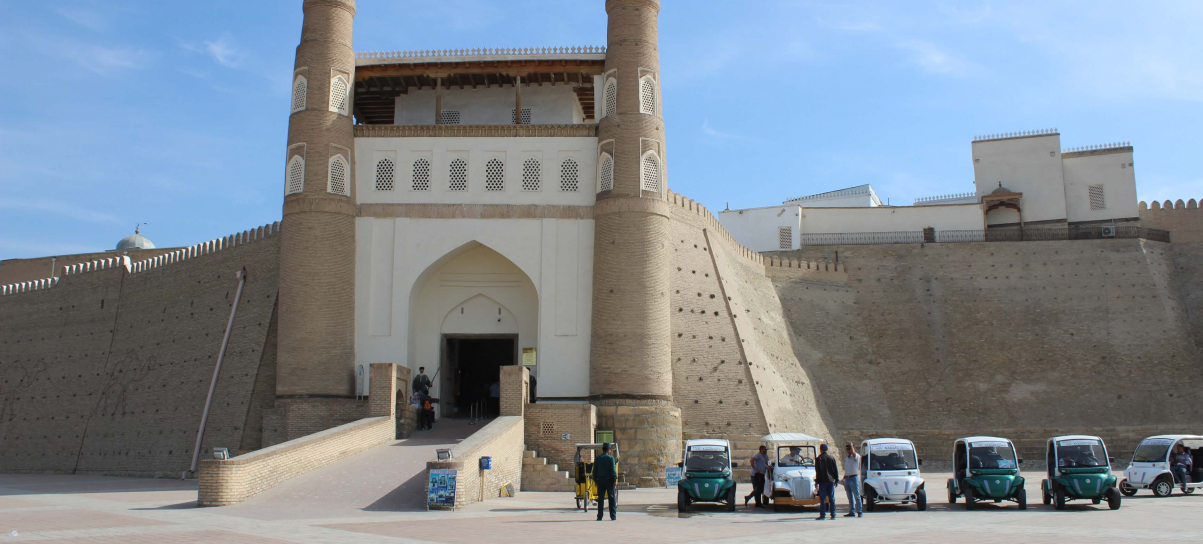The Noble Bukhara
This ancient caravan city in the lower streams of Zerafshan river was founded by migrating Indo-iranian tribes in the first milleniun BC and was known as Vikhar, Bukho and Numijkat in different periods of history.
The legend has it that Bukhara was founded by Siyavush, the legendary hero of Sogdian past.
The archeologists discovered 20 meter thick cultural layer on which modern Bukhara is situated. It was essential part of Sogdiana, the principality of Vikhar. In 329 BC city was conquered by Greek army of Alexander the Great.
The later period was marked by periods of prosperity and decline, due to migrations of different ethnic groups like Huns and Turks. In antique period the oasis of Bukhara oasis was protected from nomadic invasions by 350 km long protective walls. But these walls did not help when in the VIII century Bukhara was conquered by Arabs.
In the 7th century AD the Arab Army started raiding the oasis of Bukhara. But the real conquest of Bukhara was completed by ruthless Arab commander Kutaiba Abu Muslim in 709 AD. The local Sogdian population had to surrender and recognized Arab supremacy and derogatory conditions. The Arab conquest changed the ethnic map of the area as Bukhara was divided between Arab tribes, who settled there.
Bukhara became part of Arab Khalifat and in the later periods was ruled by governors appointed in Bagdad.
In the 9th century Nuh inb Asad, the governor of Bukhara, refused to pay taxes to Bagdad. The situation was favourable and he managed to occupy the central part of Mowarounnahr. His grandson Ismail conquered the territory from Fergana to Khorezm and founded the 1st centralized state in the territory of Mowarounnahr, with capital in Bukhara.
In 999 AD the last Samanid ruler was defeated by nomadic Karakhanids and escaped. For the next 250 years Bukhara was capital of new dynasty – Karakhanids. This periods was very remarkable from architectural point of view. Some of the best and oldest extant structures of Bukhara were built by Arslankhan, the Karakhanid.
In 1219 Bukhara was sacked by unstoppable hordes of Mongols led by Chingiz-khan. The total population of Bukhara was slaughtered or taken away to slavery by Mongols and city was destroyed.
City survived, the population returned and during the rule of Timurids in the 15th century, Bukhara got the reputation of one of the holiest cites of the world built. The best minds of Islamic World taught in hundreds of madrassahs, schools and seminaries. It became the center of enlightenment and progress.
The rulers of Shaybanid dynasty in the 16th century shifted capital to Bukhara and contributed a lot to its reputation. During the rule of Abdulla khan, there were built famous trading complexes, domed bazaars and architectural ensembles, which are still existent and which you can see during Uzbekistan tour. Caravan from far lands, including India, China, Russia and Turkey, used to travel to Bukhara because of the fame of its bazaars.
 |
Then came the time when trade declined and economic crisis drove the local fiefdoms to internecine struggle for supplies and resources. The period between 17th and end of 19th centuries is considered to be the Dark Ages in the history of Bukhara, when city was forbidden to non-Muslims and city sunk into the bottom of religious fanaticism.
In 1867 Amir Muzaffar of Bukhara was defeated by advancing Russian Army and recognized Russian supremacy and protectorate, though officially Bukhara remained independent.
In 1897 railway was brought to Bukhara and it made city closer to Europeans.
In 1920 the last representative of ruling family fled to Afganistan and Bukhara was declared People’s Republic. From 1924 till 1991 it was part of Uzbek Soviet Republic and administrative center of Bukhara Province.
|
|
After the independence Bukhara is open to the rest of the world and travelers from all around the world take Uzbekistan Tour and come to Bukhara to see its unique architectural ensembles and monuments, from fairy tales of 1001 nights
Bukhara Hotels
Bukhara Sightseeings
Pearl of the East with Central Asia tours
We recommend to see more:
Follow us on
Sign up for our newsletters
Find our latest discounted tours, updated itineraries and latest news about the region




